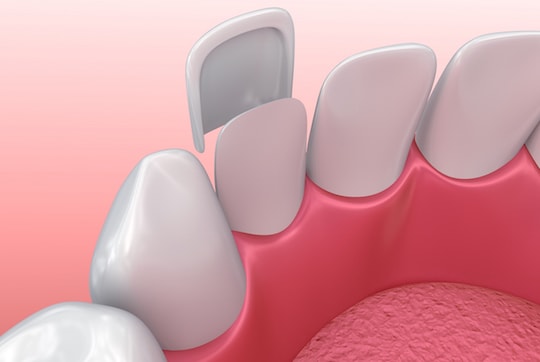Veneers are a great way to improve the shape, size or discoloration of the teeth. They can also be used to correct crooked or chipped teeth and improve the smile. However, veneers are created wafer-thin to fit over your natural teeth and they can fracture or debond. A fractured veneer can include any appearance of a crack, break or chip. Debonding means that the veneer has come off and is generally intact.
Do you know what to do if you have trouble with your veneers?
 Examine the Situation
Examine the SituationThe first thing you should do is carefully remove any pieces of the dental restoration left in your mouth without damaging them further. If it is only one piece and consists of a decent size while the outline form is rounded and somewhat symmetrical, it may have just debonded. In some cases, the dentist may be able to reattach a debonded veneer.
However, if it is broken, the dentist will have to make a new one. You should also evaluate the natural tooth to see if there are any broken segments which are still attached. If there are pieces still attached, do not try to remove them yourself but be advised that shards of porcelain can be rough or sharp to the tongue and lips.
If the porcelain veneer has debonded, storing it safely could save you the cost of having a new one made. Wrap the veneer in bathroom tissue and place it in a hard, protective container with a lid. An old medicine bottle or small Tupperware container should work just fine until you can get it safely to the dentist. If the veneer is broken, there is really nothing the dentist can do with those parts. Contact your dentist and let him or her know what has occurred. An appointment will be arranged so the dentist can evaluate your tooth and correct the issue.
Since only a minimal amount of enamel is generally removed during the initial placement of the veneer, most patients will not experience any significant problems between now and the appointment with the dentist. With debonding, the natural tooth will most likely appear like it did during the one to two weeks while the laminates were being made. With a fracture, you may experience some sharp edges along the tooth. You may feel some sensitivity to hot and cold foods or beverages. However, most drugstores sell white dental wax which can be placed over rough surfaces to provide protection against sensitivity. Simply squish a small, flattened piece of wax over the tooth and allow it to work its way between the teeth.
Once you go to the dentist, he or she will be able to trim or buff down any remaining pieces of veneer on the tooth. This should be painless and it only takes a few moments. A small chip in the porcelain may be able to be patched instead of replacing the whole thing. This is not the most ideal solution since it may not look quite the same and will not be as durable. The laminate is made of porcelain and the repair patch is plastic and is otherwise known as dental bonding. The bonding will deteriorate and stain more easily than the porcelain.
In a case where the veneer has debonded, there are several scenarios which may hinder any re-use of the veneer. The success of rebonding depends on whether the veneer and cement both separated from the natural tooth or if the cement remained attached to the tooth. Also, the dentist must be able to prepare the tooth and the veneer’s thin inner surface for the rebonding process. However, the veneer is so thin that it risks being cracked during the process. Although reattaching the veneer is worth a try, it is generally best to have the whole thing replaced.
SP